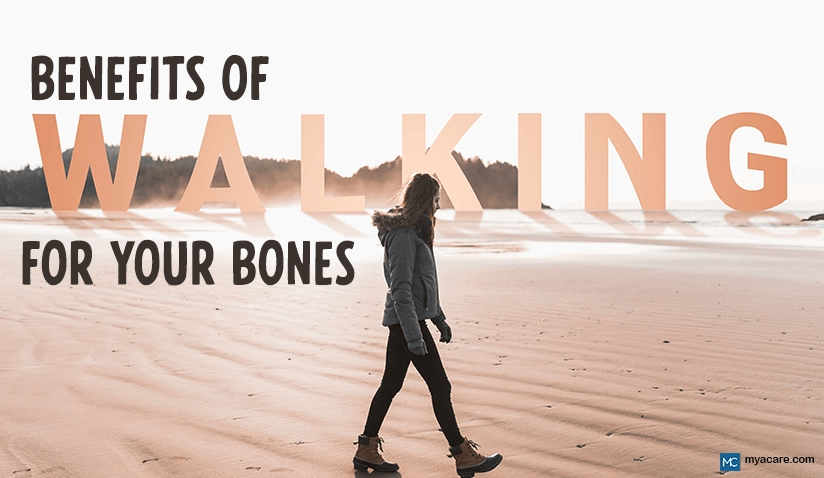The Benefits of Walking for Your Bones

Exercise is good for a person’s physical and emotional well-being. When it comes to exercise, walking is a physical activity that most people can do regardless of fitness levels. Walking is recommended as a way to help reduce bone loss. This is important since you can start to lose bone density by middle age, especially with poor dietary habits and lack of exercise. Read on to learn more about walking and ways to strengthen your bones to keep yourself healthy as you age.
Why Walking is Good for Your Bones
Walking is a type of exercise that helps reduce bone loss and retain bone strength. The physical act of walking triggers bone formation. Walking helps strengthen bones because you push against gravity while moving your limbs.
It is also safe and helpful for those starting an exercise program since walking is not as strenuous as other activities.
Furthermore, scientists have found that bone density is higher in people who walk versus those who do not. Bone density - the thickness of the bones - is essential for added strength and support.
Why Bone Density Matters
Bones have many important bodily functions besides support; muscles attach to them, and new blood cells originate from them. Blood cells are formed in an area called the bone marrow, located in the central part of bones where blood stem cells develop.
Bone tissue consists of bone cells surrounded by mineral deposits of calcium and phosphorus. The mineral deposits help to strengthen the skeletal bones.
A decrease in bone density results in a loss of strength. In time, a person can develop osteopenia which causes bone density loss. This can deteriorate into osteoporosis when bone density is so low that the bones become porous.
Osteoporosis
People with osteoporosis have weakened bones because of mineral loss. The consequence of this is a greater risk of fractures.
Osteoporosis is more prevalent in the elderly. Fractures from osteoporosis occur at rates of about 30% in older women and 20% in older men.
With advancing age, people become more prone to loss of balance and falls. Coupled with the low bone mineral density, the likelihood of fractures increases with age. Fractures are not only disabling but can lead to disability, infection, and even dangerous blood loss.
Signs of Osteoporosis
Listed below are the signs of osteoporosis.
- A reduction in height
- Back pain due to a broken vertebra
- An unusual bone fracture
Often, there are no signs of bone weakness due to density loss, which is why a DEXA scan can help. A DEXA (dual-energy X-ray absorptiometry) scan is a specific test for measuring bone density. Results can show you if you are at risk of osteoporosis.
Who is at Risk for Bone Loss?
Bone is constantly being formed (osteogenesis) and broken down (resorption). Most of the time, the rate of bone creation versus resorption is about the same.
However, the pace of bone resorption sometimes outpaces the rate at which new bone forms. This is when problems begin due to shrinking bone density. The risk factors for bone loss are discussed below.
- Women older than 50: Bone density loss is most common in females over 50.
- Menopause: Women who have entered menopause are at higher risk of bone loss. Hormonal changes after menopause impact bone tissue and how easily bone minerals are lost.
- Caucasian and Native American women: Appear to be at higher risk of bone loss than other ethnicities. However, in general, women are at higher risk of bone mineral loss than men.
- Hyperthyroidism: This hormonal problem increases the risk of bone loss.
- Certain medications: Drugs used to treat seizures can increase demineralization.
All post-menopausal women need to exercise and watch their diet to ensure they maintain strong bones and reduce bone loss. Note that while women are at higher risk, bone loss does occur in some older men as well.
Exercise for Healthy Bones
Regular physical activity is essential for bone health. Specifically, weight-bearing and resistance exercises help to build strong bones and muscles. Weight-bearing exercises are those that put weight on your bones.
Weight-bearing exercises include:
Resistance exercises aim to increase muscle strength and body strength in general. Resistance exercises include:
- Lifting weights
- Squats
- Lunges
All these exercises can improve bone health, but checking with your doctor first before starting any exercise program is essential.
Diet and Healthy Bones
Besides exercise, a healthy diet is crucial to keeping your bones strong and healthy. Calcium and vitamin D are vital for bone tissue formation. Spending time outside and getting adequate sun exposure is also important for vitamin D production.
However, excess sun exposure is a risk factor for sunburn and skin cancer, so it is essential to use sunblock for sun protection.
Many minerals such as iron, zinc, calcium, phosphorus, and magnesium are needed to ensure bone formation. A healthy diet that includes a range of nutrients and regular exercise can ensure healthy bone tissue.
Conclusion
Exercise is especially helpful for building strong bones, with walking being beneficial and suitable for people of varying fitness. Walking and other exercises help prevent bone density loss. Older people may have weaker bones and poor balance, which increases their risk of breaking bones. Both men and women can lose bone mineral density and, thus, should exercise and follow a healthy diet to maintain bone strength and density.
To search for the best Orthopedics Healthcare Providers in Croatia, Germany, India, Malaysia, Singapore, Spain, Thailand, Turkey, Ukraine, the UAE, UK and the USA, please use the Mya Care search engine.
To search for the best doctors and healthcare providers worldwide, please use the Mya Care search engine.

Dr. Rae Osborn has a Ph.D. in Biology from the University of Texas at Arlington. She was a tenured Associate Professor of Biology at Northwestern State University, where she taught many courses to Pre-nursing and Pre-medical students. She has written extensively on medical conditions and healthy lifestyle topics, including nutrition. She is from South Africa but lived and taught in the United States for 18 years.
Sources
Featured Blogs



